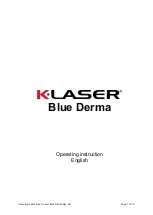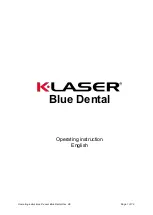
35
Reprocessing
Příprava
Aufbereitung
4. Nach Stabilisierung des Luftdrucks im Produkt
mindestens 2 Minuten warten und am
Dichtheitstester prüfen, ob der Luftdruck im
Produkt abfällt.
5.
Falls der Luftdruck abfällt, ist das Produkt
undicht und darf nicht weiterverwendet, in
Flüssigkeit eingelegt oder maschinell aufbereitet
werden. Den Reparaturbegleitschein ausfüllen.
Das Produkt mittels Wischverfahren, von
organischen Verunreinigungen/Resten reinigen
und als nicht desinfiziert kennzeichnen. Mit
KARL STORZ Kontakt aufnehmen und das
Produkt zur Reparatur an KARL STORZ
senden. Den Transportkoffer für das Produkt
mit der Transportschutzfolie 13990SFN
auslegen.
Falls der Luftdruck nicht abfällt, ist das Produkt
dicht. Die Dichtheitsprüfung: Phase 2 kann mit
dem Produkt durchgeführt werden.
1
HINWEIS:
Zur Erhöhung der Sicherheit
kann die Dichtheitsprüfung: Phase 1 auch
zusätzlich direkt nach dem Gebrauch des
Produkts durchgeführt werden.
14.3.2
Phase 2: Durchführung des
Dichtheitstests — in Flüssigkeit
1. Das Produkt in Flüssigkeit einlegen und dabei
darauf achten, dass der Dichtheitstester nicht
feucht wird.
2.
Das Produkt vollständig mit Flüssigkeit
bedecken und gegebenenfalls vorhandene
Lumen blasenfrei benetzen.
3. Mit dem Dichtheitstester Luft in das Produkt
pumpen, bis ein Druck von 160 – 180 mmHg
(blauer Bereich) erreicht ist.
Der Abwinklungsgummi am distalen Ende kann
sich leicht ausdehnen, während die Luft in das
Produkt gepumpt wird.
4. Das distale Ende über die Abwinklungs
mechanik am Kontrollkörper des Produkts
in sämtliche Richtungen bis zum Anschlag
bewegen und dabei die Druckanzeige des
Dichtheitstesters beobachten.
Der Luftdruck im Produkt kann beim Bewegen
des distalen Endes um bis zu 10 mmHg fallen.
4. After stabilizing the air pressure in the product,
wait at least 2 minutes and check on the
leakage tester whether the air pressure in the
product drops.
5. If the air pressure drops, the product is leaking
and may no longer be used, immersed in
liquid or reprocessed by machine. Complete
the repairs form. Clean the product by wiping
to remove organic soiling/residue and mark it
as not disinfected. Contact KARL STORZ and
send the product to KARL STORZ for repair.
Line the carrying case for the product with the
transport protective film 13990 SFN.
If the air pressure does not drop, the product
is leakproof. The leakage test: Phase 2 can be
performed with the product.
1
NOTE:
To increase safety, the leakage test:
Phase 1 can also be carried out directly
after using the product.
14.3.2
Phase 2: Performing the leakage
test – in liquid
1. Lay the product in liquid and ensure that the
leakage tester is not moist.
2. Fully cover the product with liquid and wet any
lumens present without bubbles.
3. Using the leakage tester, pump air into the
product until a pressure of 160 – 180 mmHg
(blue area) is reached.
The angled rubber at the distal end can
easily expand while the air is pumped into the
product.
4. Using the angling mechanism, move the
distal end on the product’s control body in all
directions as far as possible while observing
the pressure display of the leakage tester.
The air pressure in the product can drop by up
to 10 mmHg when moving the distal end.
4.
Po stabilizaci tlaku vzduchu ve výrobku
vyčkejte alespoň 2 minuty a na měřiči těsnosti
zkontrolujte, zda tlak vzduchu ve výrobku klesá.
5.
Pokud tlak vzduchu klesá, je výrobek netěsný
a nesmí být dále používán, vkládán do
kapaliny ani strojově připravován. Vyplňte
průvodní list k opravě. Výrobek otřete, zbavte
jej organických nečistot/zbytků a označte jej
jako nedezinfikovaný. Kontaktujte společnost
KARL STORZ a výrobek jí zašlete k opravě.
Přepravní kufr na výrobek vyložte přepravní
ochrannou fólií 13990 SFN.
Pokud tlak vzduchu neklesá, je výrobek
těsný. Zkoušku těsnosti (fáze 2) lze provést
s výrobkem.
1
UPOZORNĚNÍ:
Pro zvýšení bezpečnosti
lze zkoušku těsnosti: fáze 1 provést navíc i
přímo po použití výrobku.
14.3.2
Fáze 2: Provádění testu
těsnosti – v kapalině
1.
Vložte výrobek do kapaliny a přitom dbejte na
to, aby se měřič těsnosti nenavlhčil.
2.
Výrobek, a případně i lumeny, plně smočte
v kapalině bez bublinek.
3.
Měřičem těsnosti do výrobku načerpejte
vzduch, dokud není dosaženo tlaku 160 –
180 mmHg (modrá oblast).
Zatímco je do výrobku čerpán vzduch, lze
gumu na distálním konci snadno roztáhnout.
4.
S distálním koncem pohybujte pomocí ohýbací
mechaniky na ovládací rukojeti výrobku do
všech směrů až k dorazu a přitom sledujte
indikaci tlaku měřiče těsnosti.
Tlak vzduchu ve výrobku může při pohybování
s distálním koncem poklesnout až o 10 mmHg.
















































